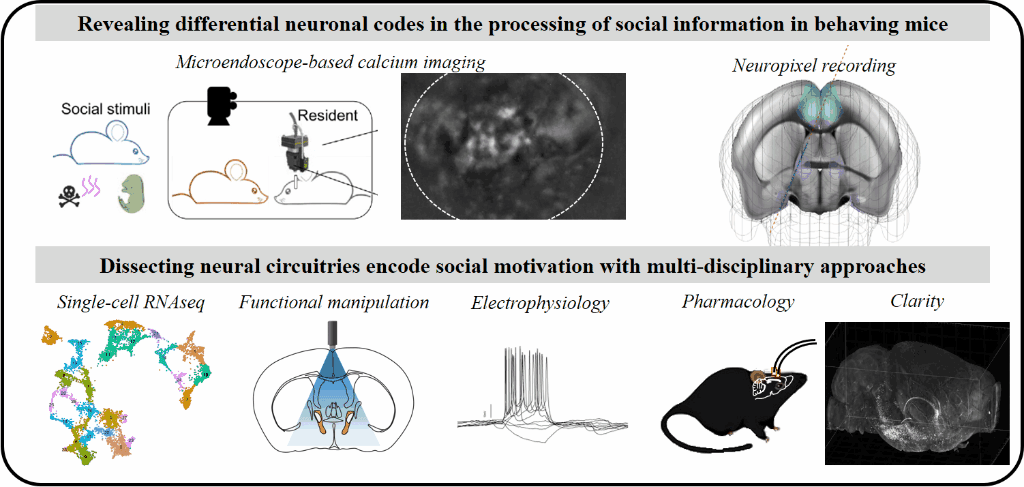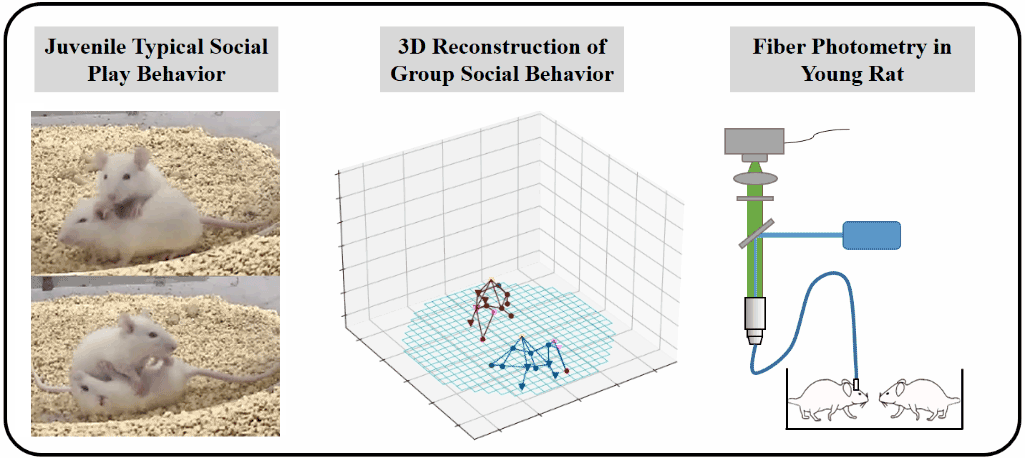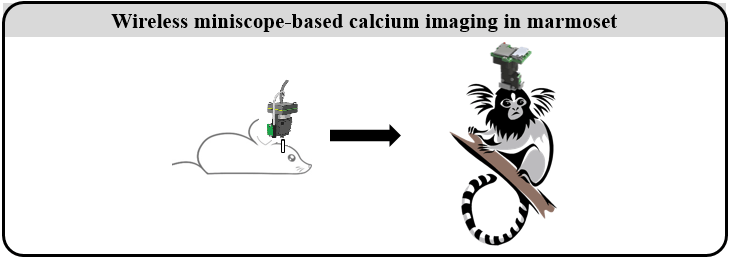Research
Across the animal kingdom, animals respond to sensory cues emitted by conspecifics, prey or predators by initiating a repertoire of social behaviors, such as mating, fighting, prey capture, and predator avoidance. Although these behaviors are driven mainly by genetically pre-programmed instinctive circuits, they are also profoundly affected by animals' internal states, developmental stages and past experience, suggesting an adaptive modulatory regulation of the underlying circuits. In rodents, the processing of chemical cues plays a crucial role in orchestrating essential instinctive social responses. The vomeronasal pathway, in particular, has been shown to generate sex-specific instinctive behavioral responses. In our lab, we aim to understand how social information is transformed through successive stages of social processing network to guide appropriate behaviors, how an individual’s internal states and developmental stages enable plasticity in these circuits, and how the neuromodulatory system is involved in this process.
Neuronal Coding of Motivation in Adaptive Social Behaviors
The readiness and tendency to express social behavior are highly plastic, influenced by external factors (e.g., conspecific identity), internal states (e.g., reproductive state), and past social experience (e.g., sexual experience). These factors collectively determine how motivated an individual is to perform social behavior. Yet relatively little is known about how the motivation of instinctive social behaviors is controlled in the brain and leads to flexible behavioral decisions and action selections. Limbic areas, in particular, the amygdala complex, the bed nucleus of stria terminalis (BNST), and the prefrontal cortex play essential roles in integrating sensory information with animals’ internal states. Such information can be further transformed in multiple hypothalamic areas to guide distinct social behaviors, suggesting that limbic areas may play essential roles in controlling social motivation and thus regulate flexible behavioral outcomes. Through a combination of endoscope-based calcium imaging, Neuropixel recording, single-cell RNA-seq, functional manipulations, pharmacology, and ex vivo brain slice recordings, we aim to reveal the neuronal codes and the functional significance of different limbic neurons that are involved in the dynamic processing of social information in freely behaving mice.

Social behaviors from juvenile to adulthood
Social behavior constantly changes as one continues to grow and develop, reaching different stages of life. The development of social behaviors can be both genetically pre-programmed (e.g. pup call, imprinting, juvenile social play) and experience-dependent. The juvenile period, in particular, plays an essential role in shaping social skills and emotions, as animals can learn from both their parents and/or related conspecifics how to interpret and react appropriately to social cues. Yet, relatively little is known about how social behaviors are changed from juvenile to adulthood, which neural circuits control juvenile typical social behaviors, and how such behaviors and neuronal controls are diminished in adulthood. Combining machine learning, genetic and in vivo calcium imaging approaches, we aim to automatically quantify detailed postures of social interactions in rats from juvenile to adulthood. This study will reveal the developmental trajectories of social behavioral motifs, and guide the mechanistic studies of social network development.

Neuromodulation involved in adaptive social behaviors
Neuromodulatory system including neuromodulators (e.g. serotonin, dopamine), neuropeptides (e.g. CCK, oxytocin) and hormones (e.g. estrogen, testosterone) play a critical role in establishing and maintaining the functional organization of the vomeronasal pathway. Our previous work (Li et al., 2017, Cell) together with many others indicate that different neuromodulatory systems play essential roles in regulating the processing of different social cues and the generation of adaptive social behaviors. Combining multi-region fiber photometry recording, genomic editing and other molecular approaches, we aim to understand how local and brain-wide dynamics of neuromodulators are orchestrated in the brain, what are the functional significances of neuromodulatory system in the aforementioned state- or development-dependent changes in social behaviors, and how are they adaptively modified in short-/long-term.

Social behaviors in marmoset
In addition to the mechanistic studies of adaptive social behaviors in rodents, we are also trying to broaden our research to social recognition in non-human primates (NHP). In NHP, social behavior relies strongly on visual and acoustic communication and, by contrast to rodents, depends minimally on chemical signaling. Studying social behaviors in NHP will provide complementary insights into the neurobiology of social behaviors and emotional reactions more related to that in humans. The marmoset, owing to its enriched social behaviors, is emerging as an ideal model for studying the neural substrates of primate social behaviors. We are currently developing wireless microendoscope-based calcium imaging to understand the neural basis of social recognition in freely behaving marmoset.







